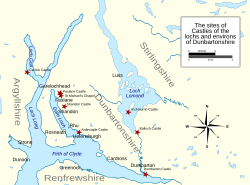Faslane Castle
| Faslane Castle | |
|
Dunbartonshire | |
|---|---|
| Location | |
| Grid reference: | NS24949016 |
| Location: | 56°4’20"N, 4°48’51"W |
| History | |
| Information | |
| Condition: | Vanished |
Faslane Castle is a castle which once stood near Faslane, in Dunbartonshire. The site of the castle was about a mile and a half north of the modern town of Shandon; and about a mile south of Garelochhead. The site sits overlooking the Gareloch and is today dominated by the HMNB Clyde.
Today nothing remains of Faslane Castle; though in the 19th century certain ruins of Shandon Castle were said to have still existed. Near the site of Faslane Castle sits the ruinous St Michael's Chapel, which has also been thought to date to the Middle Ages.

In the Middle Ages, the lands of Dunbartonshire were then part of the Lennox, and were controlled by the mormaers of Lennox. The early 13th century mormaer Ailín II, Earl of Lennox granted an extensive tract of land lying on the eastern side of the Gare Loch to one of his younger sons, Amhlaíbh. Descending from Amhlaíbh was Walter of Faslane, who was the great-grandson of Ailín II. On the death of Mormaer Domhnall, Walter became the representative of the male line of the house of Lennox. With his marriage to Margaret, daughter of Domhnall, Walter became mormaer in his own right.
The castle, according to 19th-century historian William Fraser, was said to have dated back to the 12th century. The 21st century mediævalist Geoffrey Stell compiled a census of mottes within Scotland and listed only four in Dunbartonshire—one of which is Faslane. According to Fraser, the castle was often occupied by Earls of Lennox, or members of their family.
Than to Faslan the worthy Scottis can pass,
Quhar erll Malcom was bidand at defence;
Rycht glaid he was off Wallace gud presence.—The Wallace by Blind Harry
Faslane Castle makes an appearance in the 15th century epic poem, known as The Actes and Deidis of the Illustre and Vallyeant Campioun Schir William Wallace (also called simply The Wallace, composed by the maker Blind Harry. The story runs that Wallace sacked the town of Dumbarton, and laid waste the castle of Rosneath: the modern village of Rosneath sits on the opposite side of the Gare Loch from the sites of Faslane, Shandon, and Ardincaple castles. He then proceeded across the loch to Faslane Castle, where he was warmly received by Mormaer Malcolm.
In 1543, Faslane was bestowed by Matthew Stewart, Earl of Lennox on Adam Colquhoun. In 1567, it and Garelochhead were acquired by Campbell of Ardkinlass, who sold it before 1583 to Campbell of Carrick. In 1693 it was in the hands of Sir John Colquhoun of Luss, who feud it to Archibald MacAulay of Ardincaple. According to the 19th-century historian Joseph Irving, in the mid 18th century the ruined Faslane Castle "furnished a shelter to the last representative of a once powerful family"—the last clan chief of the MacAulays of Ardincaple.[1]
Fraser stated in 1869, that no buildings or any part of the castle was then visible. He stated that the only remaining trace of the castle was a green mound, which overlooked the junction of two deep glens, between two small rivulets of which the banks were steep. William Charles Maughan stated that the site of the castle could be distinguished, at the time of his writing, "by a small mound near the murmuring burn which flows into the bay". Maughan also wrote that at Faslane there stood an oak tree at place called in Gaelic Cnoch-na-Cullah (English: "knoll of the cock"); and that according to legend, when a cock crowed beneath the branches of the old oak upon the knoll, a member of Clan MacAulay was about to die.
It has been stated that the site of Faslane Castle was destroyed when the West Highland Railway was built over top of the site, in 1891–1894.[2]
References
- ↑ CANMORE (RCAHMS) record of Faslane Castle
- ↑ McIntyre, Alistair. "Castles". www.rosneathpeninsula.org.uk. Archived from the original on March 19, 2009. https://web.archive.org/web/20090319144445/http://rosneathpeninsula.org.uk/history/castles.cfm. Retrieved 27 July 2009.